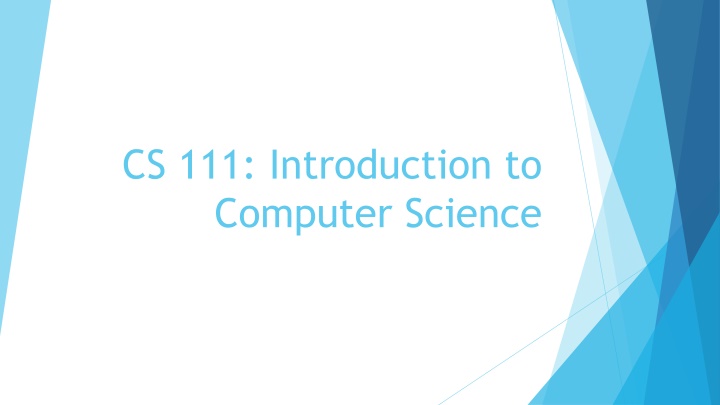
Introduction to Computer Science: Course Overview, Learning Outcomes, and Topics
Explore the fundamentals of computer science in this comprehensive course. Learn about programming, data structures, algorithms, libraries, testing, and debugging. Dive into topics like managing program complexity, programming concepts using Python, problem-solving techniques, and more. This challenging course will expand your knowledge and skills in computer science.
Download Presentation

Please find below an Image/Link to download the presentation.
The content on the website is provided AS IS for your information and personal use only. It may not be sold, licensed, or shared on other websites without obtaining consent from the author. If you encounter any issues during the download, it is possible that the publisher has removed the file from their server.
You are allowed to download the files provided on this website for personal or commercial use, subject to the condition that they are used lawfully. All files are the property of their respective owners.
The content on the website is provided AS IS for your information and personal use only. It may not be sold, licensed, or shared on other websites without obtaining consent from the author.
E N D
Presentation Transcript
CS 111: Introduction to Computer Science
A Very Brief Introduction to Computer Science
What is Computer Science? What problems can be solved using computing The study of How to solve these problems What techniques lead to effective solutions Systems Graphics Security Decision Making Robotics Ethics & Safety Natural Language Processing Answering Questions Translation Artificial Intelligence Networking Programming Languages Theory Scientific Computing Human Computer Interaction
Learning Outcomes I Computing: Write programs to accomplish tasks relevant to computer science, such as data visualization, image processing, simulations, data processing, etc. Design: Design and develop moderate to medium-sized programs for problems with significant complexity, using both object-oriented and functional paradigms. Abstraction: Effectively use modules, classes, and functions to decompose functionality of a medium-complexity system. Data Structures: Effectively choose and utilize data structures to organize data in a program. Algorithms: Effectively use basic algorithms to design and develop a program, including recursion.
Learning Outcomes II Libraries: Independently read documentation for a library, understand its operation, and incorporate the library into a program to extend its functionality. Testing and Debugging: Write unit tests to ensure complete and correct functioning of a program. Explain the meaning of error messages encountered when running a program. Use the debugger in an IDE to step through code execution and identify the source of a bug. Confidence: Demonstrate increased confidence in ability to design, develop, test, and debug programs.
Course topics Managing complexity in programs (procedural abstractions, data abstractions, programming paradigms) Deep understanding of programming concepts (using Python) How computers interpret computer programs Different types of languages (Python, Regex, Calculator, HTML) Problem solving techniques (both iterative and recursive approaches) HTML, HTTP, & the web Plotting Software design, testing, & debugging This course is challenging and often mind-blowing!
Course Prerequisites This is NOT an introductory programming class. You should have prior coding experience with variables, conditionals, branching, loops, functions, and input/output. If you do not think you have enough programming experience, consider taking CS 110 and joining us next semester.
Course Components Lectures Labs Homework assignments Projects Exams Supplemental Textbook (composingprograms.com) Office hours Everything is linked from the class website: https://cs111.byu.edu
Weekly Schedule Monday Tuesday Wednesday Thursday Friday Saturday Lecture Lecture Lab Section Lab Section Homework/ Project assignments typically due
Lab Sections Make sure you are signed up for a Lab section (006-015, 018) as well as the lecture. Each lab section has a pair of TAs that will lead the activities in those sections. You ll have the same TAs all semester. Labs will focus on small coding challenges that provide practice with materials covered in lecture in a safe, supportive environment where you can discuss problems with peers and TAs. They are a place to Take chances, make mistakes, and get messy! Miss Frizzle. Attendance is not required, but STRONGLY encouraged. Whether you attend or not, you must submit working code to the auto-grader by the end of the day for credit.
Homeworks & Projects Homework and Projects are usually due on Wednesday nights. See the course website for exact due dates. Start early, code often! These often build on and use code from your labs and previous homework assignments. The course moves fairly fast. Start early! The earlier you find you need help, the better! You can discuss the assignments at a high-level, but don't copy anyone else's code.
Exams Midterm 1: Feb 10-14 Midterm 2: Mar 17-20 Final Exam: finals week (Apr 18-23) All exams are in the Testing Center for in-person classes and online in Canvas for the online section of the class. Tests are multiple choice, with a page or two of notes and a calculator, but no accessing other resources.
Getting Help Post questions on the class Discord (invite link: https://discord.gg/zEJgc29exj) Visit the TA lab (1121 TMCB) Use the help queue: https://students.cs.byu.edu/~cs111ta/helpqueue/ Come see your professor. Check out our contact page for how to get in touch (https://cs111.byu.edu/staff/#contact/).
TAs We have an awesome group of TAs information about them. . See the course website for The TAs are regularly available five days per week in the help lab at TMCB 1121. Check the schedule at https://cs111.byu.edu/staff/#ta- lab.
TA Responsibilities TA s are responsible for: Clarifying assignments. Working with students one-on-one to help understand concepts. Help with grading. Motivate students in creative direction. TA s are NOT responsible for: Debugging student programs. Providing solutions during help sessions. 21
Student Responsibilities Students should take an active role in their learning and recognize they areaccountablefor their academic success. Be in class. Don't jeopardize your own training. Sweating a little is good. School is your brain gym. You have to work out your muscles, make them a little sore, if you're going to lift a heavier load later on. Complete the assigned work in a timely manner with attention to quality of work. Avoid making excuses for your behavior. Utilize college resources and seek help when needed. Use help queue sparingly! 22
Tip #1: Dont Get Behind If you find yourself struggling with the material, falling behind on assignments, facing personal problems, lacking motivation, or experiencing any difficulty that effects your schoolwork Resolving problems sooner is always better than later. Talk with the TAs and professor at the first sign of problems. Attend all lectures and help sessions. Work with the TAs especially in morning hours. Maximize deadlines met. Run to completion avoid context switching (distractions). There is little that can be done to improve your grade if you wait until reading day. 23
Course Policies Read the syllabus. You are responsible for knowing the information there (https://cs111.byu.edu/articles/about/). Late Policy Assignment turned in on time or early: full credit Assignment turned in up to a week late: 90% credit Assignment turned in by the end of the semester: 80% credit
Collaboration Asking questions is highly encouraged Discuss everything with each other; learn from each other! Some projects can be completed with a partner Choose a partner from your lab section The limits of collaboration Please don t look at someone else's code! Exceptions: lab, your project partner, or after you already solved the problem Please don't tell other people the answers! You can point them to what is wrong and describe how to fix it, but don't tell them what to type, and don't type for them Copying project solutions causes people to fail the course We really do catch people who violate the rules, and we're getting better at it.
Community Guidelines Your goal should be to learn and help others learn. Even though everyone here has programming experience, there is still a wide range of experience levels. All are welcome! There are no "stupid" questions. Ask all your questions and welcome everyone else's questions.
Using Large Language Models (ChatGPT and the like) These can be quite useful for helping you to understand a topic and to answer specific questions. On the class Discord server, you can ask questions in the Duck Pond channel. The rubber duck is powered by ChatGPT and is designed to be a "Virtual TA" to help you with concept questions You should NOT be asking LLMs to give you code for your assignments. They will happily do so, but We expect you to write the code yourself. The code from the LLMs is often wrong or uses advanced material we're not covering in class. When you go to get help from the TAs, the first thing they will do is ask you to explain your code and what it is doing.
More on the use of AI Elder Bednar gave a great talk, "Things as They Really Are 2.0," in his Young Adult Devotional in Nov. 2024. Link to the full talk you should watch this if you haven't yet. This should be your guiding principle in using AI in this class. Some key excerpts:
What do programs do? Programs work by manipulating values Expressions in programs evaluate to values Expression: 'a' + 'hoy' Value: 'ahoy' The Python interpreter evaluates expressions and displays their values Statements give direction to the program assigning values defining things determining program flow
Values Programs manipulate values. Each value has a certain data type. Data Type Integers Floats Booleans Strings Example Values 2 44 -3 3.14 4.5 -2.0 True False ' hola!' 'its python time!' Try these in a Python interpreter. What gets displayed?
Expressions (with operators) An expression describes a computation and evaluates to a value. Some expressions use operators: addition: 18 + 69 subtraction: 2024 - 1972 multiplication: 2 * 100 division floating point: 23/6 integer: 23//6 modulus: 23 % 6 Try these in a Python interpreter. What gets displayed?
Call Expressions Many expressions use function calls: pow(2,100) max(50, 300, -1600) min(1, -300, -67) Function calls are a type of expression, called a call expression, and like operator expressions evaluate to some value.
Anatomy of a Call Expression add ( 18 , 69 ) Operator Operand Operand How Python evaluates a call expression: Evaluate the operator 1. Evaluate the operands 2. Apply the operator (a function) to the evaluated operands (arguments) 3. Operators and operands are also expressions, so they must be evaluated to discover their values.
Evaluating nested expressions 45 add(add(6, mul(4, 6)), mul(3, 5)) 30 15 add add(6, mul(4, 6)) mul(3, 5) 24 add 6 mul(4, 6) mul 3 5 This is called an expression tree. mul 4 6
